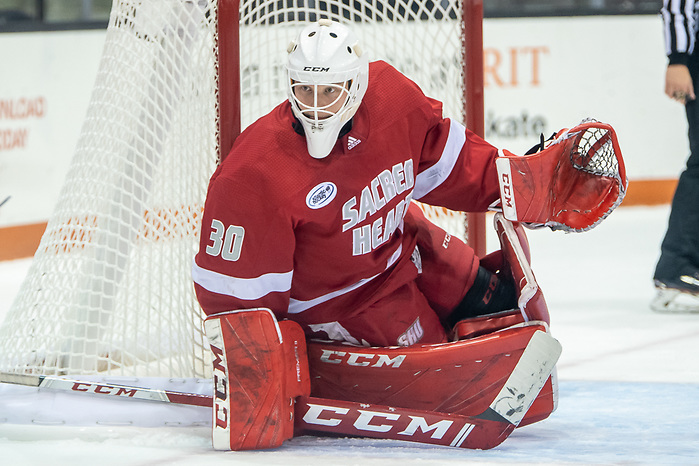
Each week during the season, we look at the big events and big games around Division I men’s college hockey in Tuesday Morning Quarterback.
Paula: Just last week, Jimmy, we were speculating that North Dakota may look like a lock on the NCHC regular-season title and — just like that — Minnesota Duluth says, “Um, not so fast.”
The Bulldogs took advantage of North Dakota’s bye week with a home sweep of Omaha, pulling to within two points of the first-place Fighting Hawks. North Dakota has two games in hand on Duluth and the Bulldogs play their next four games on the road, but the Bulldogs are going to make this interesting.
Minnesota Duluth was not in the best position to chase first place after the first half of the season, so the Bulldogs’ second-half performance to get to this point is particularly impressive, as is their climb to fourth place in the PairWise.
Jim: Certainly, the Bulldogs have made the NCHC race a little more interesting.
North Dakota still should have a leg up, not just with a two-point lead but also the two games in hand they still have, as you pointed out. The big test comes this weekend when the Fighting Hawks host Denver. If North Dakota stumbles, that could open the window for Minnesota Duluth to crawl into the top spot in the standings. But two wins, and I feel like we can begin anointing North Dakota as champions.
What has been interesting about Minnesota Duluth’s move up the NCHC standings is how the Bulldogs have also ascended the PairWise. Currently fourth in the PairWise, that doesn’t just impact the Bulldogs. There is another team happy to see UMD’s success: UMass Lowell.
Some may remember that way back on the opening weekend in Duluth, the River Hawks earned a 3-2 victory. Though it seems so long ago, the bonus points associated with that victory keep increasing for UMass Lowell and, combined with wins over Boston College and Merrimack this past weekend, that helps push Lowell up to 11th in the PairWise.
We seemingly say it every year: A win in October is as valuable as a win in March. Well, for Lowell, that October win at Minnesota Duluth keeps getting more valuable with each and every Bulldog victory.
Paula: We are at that point where we can look at how wins and losses earlier in the season will affect where teams land in March.
Cornell’s outstanding first half is protecting the Big Red somewhat from a difficult January in which the team went 3-1-4 – not a horrible stretch, but one that certainly would have done more damage to Cornell’s PWR were it not for that first half.
Then there’s a team like Ohio State, which proves that no matter how good your first half is, you still have to get the job done down the stretch. The Buckeyes tied and lost to Penn State this past weekend and dropped all the way to No. 15 in the PWR. Ohio State is 4-5-1 in its last 10 games, dating to the start of the calendar year. A team that once looked to be competing for a No. 1 seed in the NCAA tournament is now on the bubble.
The teams making strides in the Big Ten – like Minnesota and Michigan – remind me that is often no amount of making up for a bad first half, unless you’re playing in a really strong league, like Maine.
We always wonder, Jimmy, about those teams that have great second halves that really struggled up until then. Jeff Jackson talked about Notre Dame’s lack of confidence in the first half. Mel Pearson talked about a team that was just this close to being complete, and Bob Motzko has a young team. In the second half, while it would be difficult for any of those teams to capture the regular-season title, any one of them could emerge the Big Ten playoff champion.
Who are you seeing in other leagues, Jimmy, that are on the PWR bubble or below the bubble but who could capture a conference playoff championship and maybe make some noise in the NCAA tournament?
Jim: Well, I see a team like Bemidji State, which is right below the positive side of the bubble, that certainly is deep enough to either make a run to a title or win enough games down the stretch to earn an at-large bid.
We know Michigan State has the goaltender to get them through a postseason gauntlet. And Harvard has the speed and skill if they get back-end support to win the Cleary Cup in the ECAC.
Then there is BU. Granted we are writing this before the Terriers face off against Northeastern in the Beanpot final, but everything I have seen of this team in recent weeks indicates that their youth and talent are finally coming around to put together a competitive club that easily could stir up postseason trouble, especially if they get home ice in Hockey East.
The one league that befuddles me right now is Atlantic Hockey. Though the PairWise doesn’t indicate it, Sacred Heart is as good as any and could be dangerous if they reach the NCAA tournament. That, though, is a long road through a tough Atlantic Hockey field that includes the experience of AIC, the grit of Army, and the skill of RIT.
That may be the most interesting playoff gauntlet, knowing there is no tomorrow with any loss.
Paula: Atlantic Hockey is so exciting this season.
Like you, I don’t quite understand why the league as a whole hasn’t risen more in the PWR or RPI, as the league as a whole has improved significantly the last several seasons. Of course, what we’re seeing with Atlantic Hockey is what we saw when the WCHA was reconfigured when the Big Ten was formed. That conference wasn’t especially deep in terms of the number of teams that were consistently competitive and so the conference as a whole suffered.
Now, though, Minnesota State has positioned itself to build something really lasting, and Bemidji (as you mentioned) and Northern Michigan are bubble teams. Alaska continues to play good hockey. Michigan Tech, Bowling Green and Lake Superior State are teams that are in a good middle mix.
In Atlantic Hockey for a couple of seasons now, we’ve seen the emergence of American International, Bentley and Sacred Heart especially. Air Force and RIT have been competitive in recent seasons, and Army is emerging.
But it’s the depth of that conference that hasn’t quite developed yet. I’ve said this before, I know, but it seems a shame that only one team from the AHA will make it into the NCAA tournament. It also seems, though, that we’re not that far off from an Atlantic Hockey conference that may consistently produce at least one at-large NCAA team annually.
Jim: Certainly, Atlantic Hockey has improved, but as you mentioned, the league is a bit top-heavy.
As much as I was thinking that the conference was stronger out-of-conference, I just checked the overall winning percentage and it is .277. If this conference can’t raise that number about .450 or so, there’s so little chance they will ever get more than their conference champion into the NCAA tournament.
What continues to interest me and makes me wonder if we will ever see is if Atlantic Hockey ever gets on pure par with the other five leagues – in other words, that on any given year, most leagues, for the most part, can average three teams year in and year out.
Right now, we have some conferences that are more balanced, and those are the leagues that get the most teams into the national tournament.


